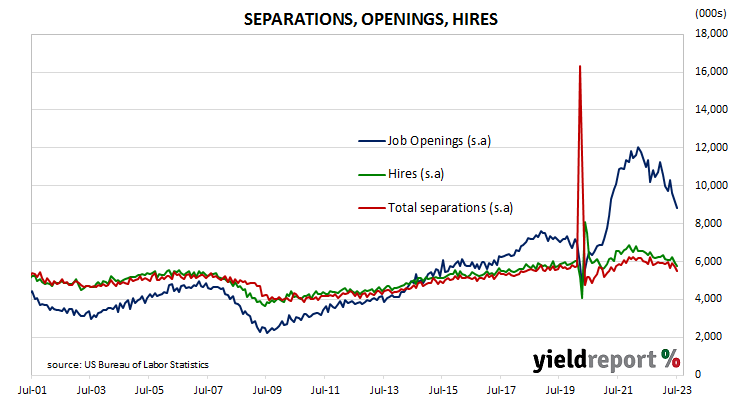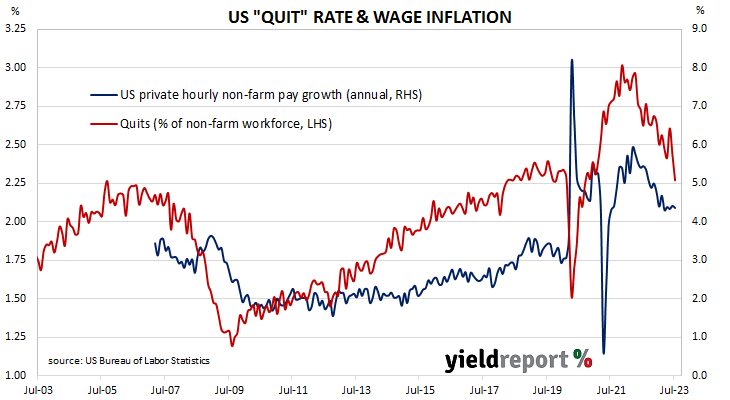Summary: US quit rate slips to 2.3% in July; ANZ: rate back in line with pre-pandemic readings; US Treasury yields fall significantly; expectations of Fed rate cuts in 2024 harden; Citi: very much in line with soft-landing view; quits, separations, openings all down.
The number of US employees who quit their jobs as a percentage of total employment increased slowly but steadily after the GFC. It peaked in March 2019 and then tracked sideways until virus containment measures were introduced in March 2020. The quit rate then plummeted as alternative employment opportunities rapidly dried up. Following the easing of US pandemic restrictions, it proceeded to recover back to its pre-pandemic rate in the third quarter of 2020 and trended higher through 2021 before easing through 2022 and the first half of 2023.
Figures released as part of the latest Job Openings and Labor Turnover Survey (JOLTS) report show the quit rate slipped in July, maintaining its recent downtrend. 2.3% of the non-farm workforce left their jobs voluntarily, down from 2.4% in June. Quits in the month fell by 253,000 while an additional 187,000 people were employed in non-farm sectors.
“The quits rate, a gauge of voluntary separations and often seen as a barometer of buoyancy in the labour market, fell back to 2.3%,” said ANZ economist Kishti Sen. “That gauge is now in line with pre-pandemic readings and suggests that worker optimism at being able to leave their jobs and find another one easily has normalised.”
The figures were released on the same day as the latest conference Board consumer confidence report and US Treasury yields finished the day significantly lower, especially at the short end of the curve. By the close of business, the 2-year Treasury bond yields had shed 15bps to 4.90%, the 10-year yield had lost 9bps to 4.12% while the 30-year yield finished 5bps lower at 4.23%.
In terms of US Fed policy, expectations of a lower federal funds rate in 2024 hardened. At the close of business, contracts implied the effective federal funds rate would average 5.34% in September, slightly above the current spot rate, and then average 5.365% in October. December futures contracts implied a 5.45% average effective federal funds rate while August 2024 contracts implied 4.82%, 51bps less than the current rate.
Citi senior economist Andrew Hollenhorst expanded on Sen’s point. “The combination of a pre-pandemic quit rate and a ratio of openings to unemployed individuals that is steadily falling back toward a pre-pandemic norm is very much in line with the dovish soft-landing view.”
The fall in total quits was led by 166,000 fewer resignations in the “Accommodation and food services” sector while the “Retail trade” sector experienced the largest gain, increasing by 41,000. Overall, the total number of quits for the month fell from June’s revised figure of 3.802 million to 3.549 million.
Total vacancies at the end of July dropped by 338,000, or 3.7%, from June’s revised figure of 9.165 million to 8.827 million. The fall was driven by a 198,000 loss in the “Professional and business services” sector while the “Information” sector experienced the single largest increase, rising by 101,000. Overall, 10 out of 18 sectors experienced fewer job openings than in the previous month.
Total separations decreased by 208,000, or 3.7%, from June’s revised figure of 5.691 million to 5.483 million. The fall was led by the “Accommodation and food services” sector where there were 132,000 fewer separations than in June. Separations decreased in 10 of the 18 sectors.

The “quit” rate time series produced by the JOLTS report is a leading indicator of US hourly pay. As wages account for around 55% of a product’s or service’s price in the US, wage inflation and overall inflation rates tend to be closely related. Former Federal Reserve chief and current Treasury Secretary Janet Yellen was known to pay close attention to it.


